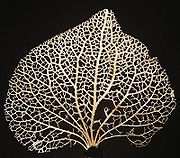
Microphyll
Encyclopedia

Traditionally, a microphyll is "an appendage supplied by a single, unbranched vein". Despite their name, microphylls are not always small; those of Isoëtes can reach centimetres in length, and the extinct Lepidodendron
Lepidodendron
Lepidodendron is an extinct genus of primitive, vascular, arborescent plant related to the Lycopsids . It was part of the coal forest flora. They sometimes reached heights of over , and the trunks were often over in diameter, and thrived during the Carboniferous period...
bore microphylls over a metre long. In the classical concept of a microphyll, this vein emerges from the protostele
Stele
A stele , also stela , is a stone or wooden slab, generally taller than it is wide, erected for funerals or commemorative purposes, most usually decorated with the names and titles of the deceased or living — inscribed, carved in relief , or painted onto the slab...
, without leaving a leaf gap. Leaf gaps are small areas above the node of some leaves where there is no vascular tissue, as it has all been diverted to the leaf. Megaphylls are characterised by multiple venation. By this definition, the Psilotopsids
Psilotopsida
Psilotopsida is a class of fern-like plants. It should not be confused with the obsolete class Psilophytopsida. As circumscribed by Smith et al. Psilotopsida contains two families, Psilotaceae and Ophioglossaceae, placed in orders Psilotales and Ophioglossales, respectively...
, Lycopods and Equisetum have microphylls, as all extant individuals only bear a single vascular trace in each leaf.
Evolution of leaves: Microphylls and Megaphylls

Enation
Enations are scaly leaflike structures, differing from leaves in their lack of vascular tissue. They are created by some leaf diseases. Also found on some early plants such as Rhynia, where they are hypothesized to aid in photosynthesis....
s, developed from the side of early axes (such as those found in the Zosterophylls). Outgrowths of the protostele later emerged towards the enations (as in Asteroxylon
Asteroxylon
Asteroxylon is an extinct genus of plants of the Division Lycopodiophyta known from anatomically preserved specimens in an Early Devonian deposit of chert at Rhynie, Aberdeenshire in North-East Scotland that has been dated at...
), and eventually continued to grow fully into the leaf to form the mid-vein (such as in Baragwanathia
Baragwanathia
Baragwanathia is a genus of extinct plants of the division Lycopodiophyta of Late Silurian to Early Devonian age , fossils of which have been found in Australia, Canada and China.-Description:...
). The fossil record appears to display these traits in this order, but this may be a coincidence, as the record is very incomplete: microphylls may have originated by the reduction of a webbed telome branch.
Exceptions
Unfortunately, the simplistic models described above do not hold true for all organisms. Some genera of ferns display complex leaves which are attached to the pseudostele by an outgrowth of the vascular bundle, leaving no leaf gap. Horsetails (Equisetum) bear only a single vein, and appear to be microphyllous; however, in the light of the fossil record, we conclude that their forbears bore leaves with complex venation, and the current state is a result of secondary simplification. Some gymnospermGymnosperm
The gymnosperms are a group of seed-bearing plants that includes conifers, cycads, Ginkgo, and Gnetales. The term "gymnosperm" comes from the Greek word gymnospermos , meaning "naked seeds", after the unenclosed condition of their seeds...
s bear needles with only one vein, but the gymnosperms evolved later from plants with complex leaves.

Psilotum
Psilotum is a genus of fern-like vascular plants, one of two genera in the family Psilotaceae, order Psilotales, and class Psilotopsida...
, which bears a protostele, and enations devoid of vascular tissue. Consequently, Psilotum was long thought to be a "living fossil" closely related to early land plants (Rhyniophytes). However, genetic analysis has shown Psilotum to be a reduced fern.
To make matters worse, there is also some debate about whether leaf gaps are unique and/or common to megaphyllous organisms.
This ambiguity leaves it difficult to distinguish between two competing hypotheses: that microphylls evolved via the reduction of megaphylls, and that they evolved independently, from enations. While the simple definitions (microphylls: one vein, macrophylls: more than one) can still be used in modern botany, the evolutionary history is harder to decipher.

